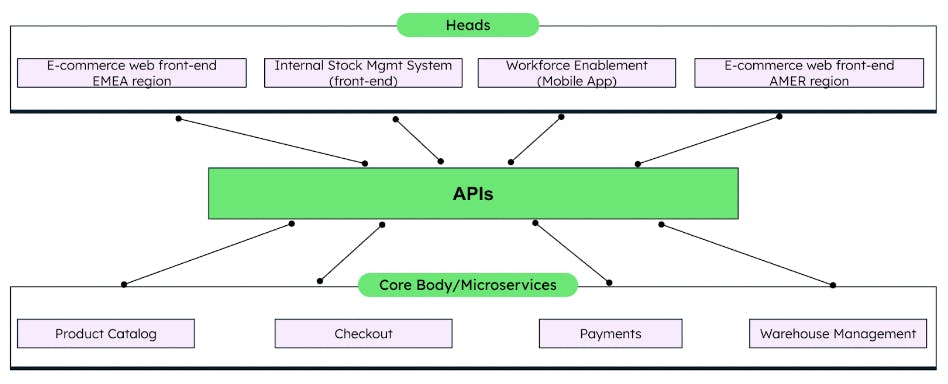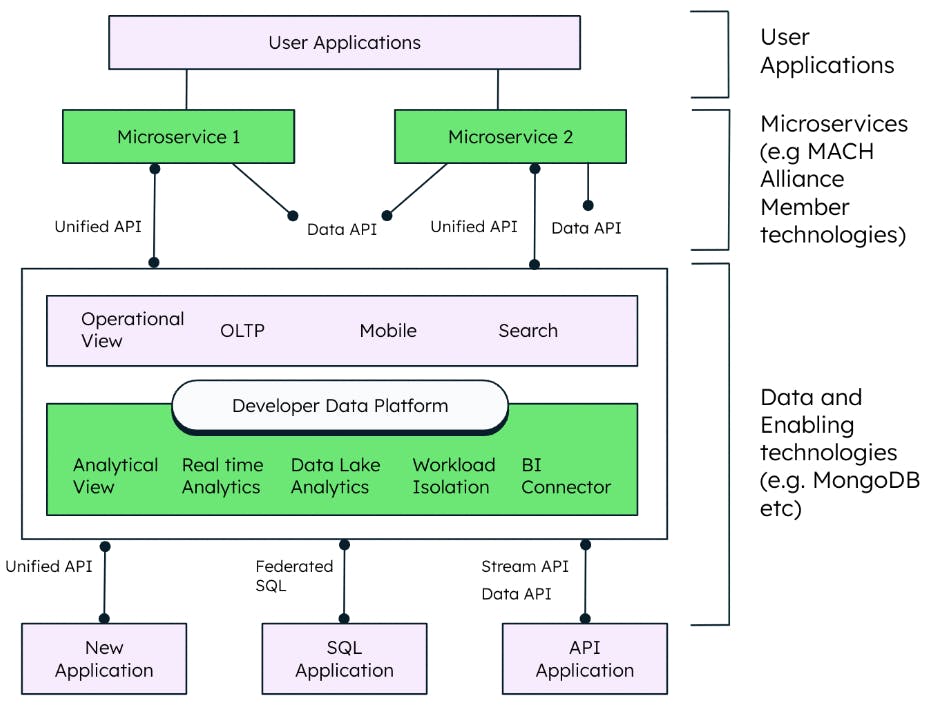MACH Aligned for Retail: Headless
>> Announcement: Some features mentioned below will be deprecated on Sep. 30, 2025. Learn more.
The MACH Alliance is a non-profit organization fostering the adoption of composable architecture principles, namely Microservices, API-First, Cloud-Native SaaS, and Headless. MongoDB, among many other technology companies, is a member of this Alliance, enabling developers to adopt these principles in their applications.
In this article, we’ll focus on the fourth principle championed by the MACH Alliance: Headless. Let’s dive in.
What is headless?
A headless architecture is one where the layers or components of the architecture are decoupled. The “heads” (i.e., frontends) operate independently from the backend logic or “core body” microservices and share data via API.
This concept is key to a successful shift toward microservices — without decoupling the architectural layers, you’re running on a modern monolith. Looser coupling also leads to an increase in frontend change and flexibility, reusability of core features, less downtime because there’s no single point of failure, and promotes reusability of key features.
Headless applied to retail
Retail was one of the first industries to embrace headless architectures, with the term coined in 2012 by Dirk Hoerig, founder of commercetools. These concepts were originally applied to building modern ecommerce solutions and are now being expanded to any application in the IT stack.
In this model, the head can be an ecommerce web frontend, or mobile app, or an internal frontend system for stock management. The core body components support the heads (Figure 1). They can be a payment system, a checkout solution, a product catalog, or a warehouse management application.

Customers and their experiences are at the heart of retail. Adopting headless principles can greatly help companies meet rapidly changing customer requirements and stand out from the competition. Customers require a seamless journey between mobile, web applications, and in-store with data and logic consistent across channels. New channels might also need to be added such as integration with social media, to reach a younger customer base.
Retailers might need to be able to sell in multiple regions or across product lines, requiring them to adopt multiple frontends to serve different customer groups without having to rewrite or duplicate the whole IT stack. New features might need to be added quickly to reflect competitors’ moves without tracing changes back through every component of the stack or experiencing downtime. Internal workforce systems can follow similar principles.
The common denominators of these example use cases include speed of change and frontend flexibility, avoiding downtime, and reusability of the backend components. Headless solutions enable developers to avoid duplicating efforts by reusing the core capabilities of applications and adapting them to various target systems and use cases. Those principles save developers’ time and can be leveraged to provide a seamless experience to customers, as the underlying data layer and workflows are shared across multiple services offering similar functionalities.
Headless architectures also come with the following advantages.
Bring new features to market faster
New features and MVPs can be introduced with minimal impact on other application components. Release cycles can be managed efficiently via a microservice architecture relying on different squads, and new releases can be pushed to production when ready, independently of the work of other squads. For example, a retailer can expand into a new country quickly by developing a country-specific frontend that reuses existing core components and requires no backend downtime.
Scale to meet seasonal demand
Companies can independently scale application components where and when required. For example, increased user traffic might require more resources to support frontend components, leaving the backend untouched and vice versa. In an ecommerce scenario, this can take the form of expected deviations from a seasonality standpoint (e.g., end-of-month transactions following salary distribution, holiday shopping) or unplanned variations (e.g., influencer marketing). Thus, this model can result in:
-
Cost savings: Achieve cost reductions as a headless architecture running on the cloud enables to further decouple its pay-as-you-go model, by only paying for the infrastructure required by each front/backend component.
-
Improved customer experience: Develop highly available and responsive applications so that customer experience is not affected by computing resources.
Leverage best-of-breed technologies
Headless architectures can help companies gain greater flexibility in deploying and managing the IT stack, allowing them to:
-
Focus on value-add development: A composable headless architecture enables companies to choose to build or buy individual components in the stack. As the components are decoupled, it becomes easier to unpick than if the stack is fully integrated — as the APIs can be redirected to the new solution more easily. This approach lets companies put their development activity into value-added functionality should a best-of-breed vendor solution arrive on the market delivering core functionality.
-
Avoid vendor lock-in: This also allows for more seamless technology switches should companies decide to bring development back in-house or switch vendors.
-
Improve talent acquisition and retention: Deploying in a flexible and composable manner lets development teams choose the programming languages and tools they feel best match the requirements, allowing companies to attract and retain top talent.
Less downtime with faster troubleshooting
A headless architecture also makes it easier to pinpoint which single layer/component is the root cause of issues, as opposed to troubleshooting in monolithic applications where dependencies can be difficult to map. Fewer dependencies mean less downtime; when a change or failure occurs to one component, it doesn't affect the whole stack. For ecommerce retailers, any downtime can have a direct impact on revenue, so an architecture that supports a move towards 24/7 uptime is ideal.
Removing data silos and sharing data across multiple journeys also enables companies to implement truly omnichannel experiences and leverage the datasets for other downstream processes, such as user personalization and analytics.
How can MongoDB help?
Headless architectures require a strong data layer to reap all the above-mentioned benefits. MongoDB includes several key features that enable developers to speed up the pace of delivery of new features and bug fixes, scale with minimal effort, and leverage APIs to share data with the different components of the stack.
Deliver faster with no downtime
MongoDB provides a flexible document model that easily adapts to the needs of different microservices and supports adding new features and data fields without having to rethink the underlying data schema or experience downtime.
Let’s consider a product catalog microservice that uses a particular API to read data from certain fields. A second microservice can be developed requiring the same set of fields as the first along with a few new ones connecting via a new API. MongoDB allows the change to be made with no downtime of the product catalog microservice and related API.
Scale effortlessly
Adding new features and services will likely require scaling the data layer to cater to higher storage and workload. MongoDB, through its sharding capabilities, enables a distributed architecture by horizontally scaling the data layer and by distributing data across multiple servers. This approach can provide better efficiency than a single high-speed, high-capacity server (vertical scaling), to build highly responsive retail solutions.
Support composable architectures
MongoDB also possesses strong API capabilities to support a microservice-based backend architecture and make data accessible and shareable across components (Figure 2). These capabilities include APIs and drivers supporting a dozen programming languages on the market, such as C, Python, Node.js, and Scala. The MongoDB Unified Query API allows working with data of any type, including time series, arrays, and geospatial.
MongoDB Atlas, MongoDB’s modern database, comes with the Atlas Data API allowing to programmatically create, read, update, and delete data stored on Atlas clusters as part of standard HTTPS requests.

Data availability and resiliency should also be considered when adopting headless architectures. MongoDB Atlas clusters are highly available and backed by an industry-leading uptime SLA of 99.995% across all cloud providers. If a primary node becomes unavailable, MongoDB Atlas will automatically failover in seconds. Clusters can be also deployed across multiple cloud regions to weather the unlikely event of a total region outage, or in multiple cloud platforms together.
Summary
Adopting a headless architecture is paramount for retailers wanting to enhance customer experience and build more resilient applications. MongoDB, with its leading database offering, API layer, and high availability is strongly suited to meet the requirements of modern applications.
Read our previous blog posts in the MACH series covering Microservices, API-First, and Cloud-Native SaaS.